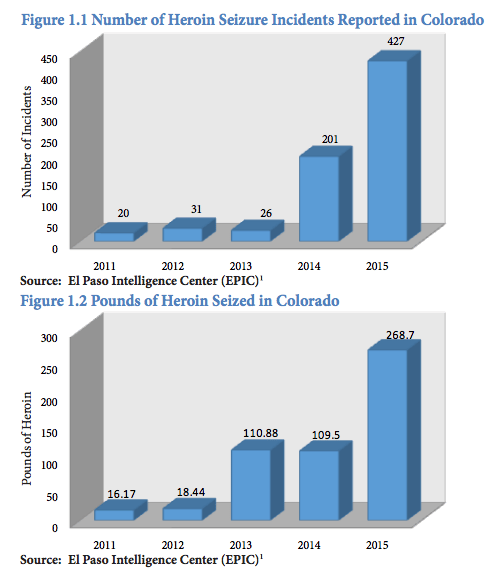
Authorities seized about 269 pounds of heroin in Colorado in 2015, nearly 17 times more than they had in 2011.
That's just one of many troubling findings in "Heroin in Colorado," one of the most comprehensive examinations yet of the opioid crisis in this state. Published today, the report shows remarkable spikes both in use and in police action on heroin.
Heroin is becoming more broadly available, with its price in Denver plunging from $308 a gram to just $123 a gram between 2011 and 2015, according to Drug Enforcement Administration figures.
And that spike in confiscations wasn't just a fluke: Those 269 pounds of heroin were confiscated in 427 different incidents in 2015, compared to just 20 incidents in 2011.
The spread of the drug has had an undeniable human impact: Nearly 4,600 people were arrested for heroin offenses in Colorado in 2015, roughly five times more than in 2011. And heroin deaths have doubled, from 79 in 2011 to 160 in 2015.
Heroin's also getting less pure, dropping from 32 percent purity to 17 percent, according to the DEA's monitoring program. Meanwhile, the prevalence of Hepatitis C, which can be transmitted through shared syringes, has nearly doubled alongside increased heroin use. Nearly half of people admitted for heroin treatment reported a history of mental health problems.
And while it's true that heroin use is associated with rural areas, the cities have not escaped it. Denver's rate of fatal heroin overdoses was in the third quartile for all counties in the state, joining the rural counties of southwestern Colorado. Pueblo had the highest rate in the state.

Why is this happening?
There's a strong link between the increased prescription of opioid painkillers and the abuse of heroin.
Painkillers grew in popularity for nearly 20 years straight after OxyContin was introduced and doctors began to distribute painkillers more widely in the mid-1990s.
Some 70 percent of Denver-area heroin users said that prescription painkillers had played a role in their use of heroin, according to a survey in the new report.
The report also complicates the image of a drug addict: 46 percent in the Denver survey said they largely paid for their drugs with legal income.
What's next?
The Heroin Response Work Group next will create recommendations for policy and programs. The group includes law enforcement, the DEA, the Colorado National Guard and the Colorado Department of Public Health and Environment.
The state last year began more broadly distributing naloxone, a drug that can save lives during overdoses.
In December, the U.S. Congress approved $1 billion in grant money for states to "fund prescription drug monitoring, increase opioid abuse and overdose prevention training, improve doctors’ prescribing practices, expand access to addiction treatment, and support other public health initiatives related to drug abuse," as Vox reported.
Locally, state Rep. Brittany Pettersen, whose mother has been addicted to heroin, is sponsoring bipartisan legislation to put more money into addiction research.












